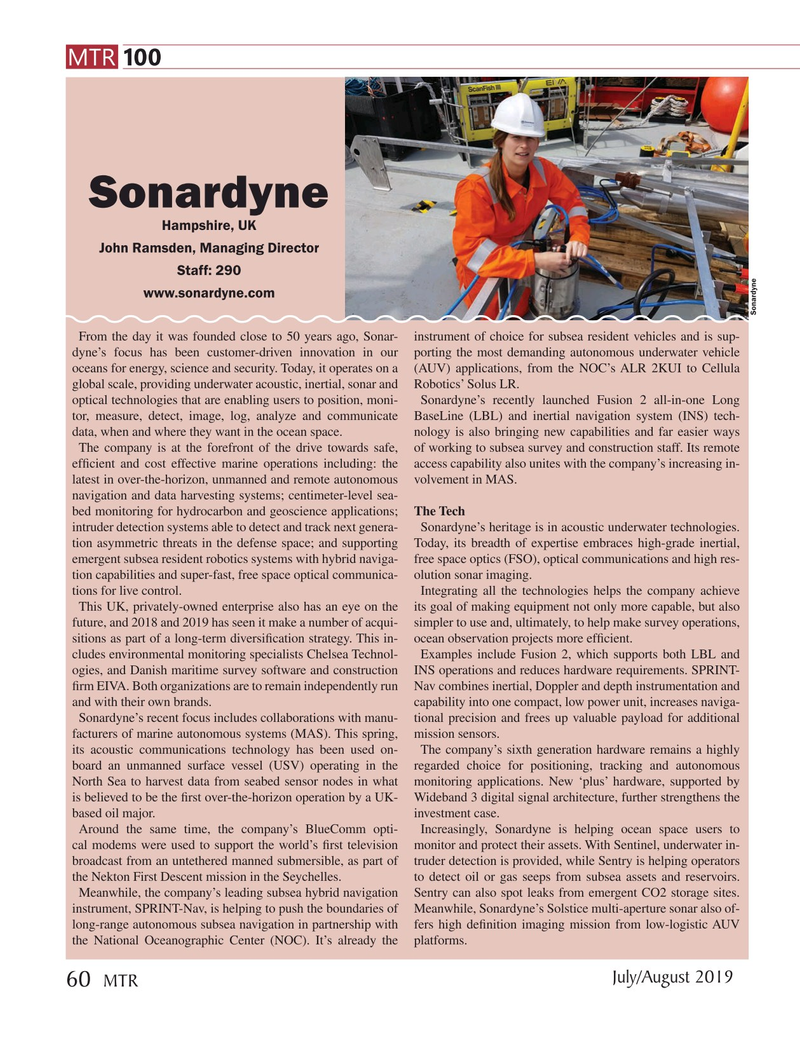
Page 60: of Marine Technology Magazine (July 2019)
MTR White Papers: Hydrographic
Read this page in Pdf, Flash or Html5 edition of July 2019 Marine Technology Magazine
MTR 100
Sonardyne
Hampshire, UK
John Ramsden, Managing Director
Staff: 290 www.sonardyne.com
Sonardyne
From the day it was founded close to 50 years ago, Sonar- instrument of choice for subsea resident vehicles and is sup- dyne’s focus has been customer-driven innovation in our porting the most demanding autonomous underwater vehicle oceans for energy, science and security. Today, it operates on a (AUV) applications, from the NOC’s ALR 2KUI to Cellula global scale, providing underwater acoustic, inertial, sonar and Robotics’ Solus LR. optical technologies that are enabling users to position, moni- Sonardyne’s recently launched Fusion 2 all-in-one Long tor, measure, detect, image, log, analyze and communicate BaseLine (LBL) and inertial navigation system (INS) tech- data, when and where they want in the ocean space. nology is also bringing new capabilities and far easier ways
The company is at the forefront of the drive towards safe, of working to subsea survey and construction staff. Its remote ef? cient and cost effective marine operations including: the access capability also unites with the company’s increasing in- latest in over-the-horizon, unmanned and remote autonomous volvement in MAS. navigation and data harvesting systems; centimeter-level sea- bed monitoring for hydrocarbon and geoscience applications; The Tech intruder detection systems able to detect and track next genera- Sonardyne’s heritage is in acoustic underwater technologies. tion asymmetric threats in the defense space; and supporting Today, its breadth of expertise embraces high-grade inertial, emergent subsea resident robotics systems with hybrid naviga- free space optics (FSO), optical communications and high res- tion capabilities and super-fast, free space optical communica- olution sonar imaging.
tions for live control. Integrating all the technologies helps the company achieve
This UK, privately-owned enterprise also has an eye on the its goal of making equipment not only more capable, but also future, and 2018 and 2019 has seen it make a number of acqui- simpler to use and, ultimately, to help make survey operations, sitions as part of a long-term diversi? cation strategy. This in- ocean observation projects more ef? cient.
cludes environmental monitoring specialists Chelsea Technol- Examples include Fusion 2, which supports both LBL and ogies, and Danish maritime survey software and construction INS operations and reduces hardware requirements. SPRINT- ? rm EIVA. Both organizations are to remain independently run Nav combines inertial, Doppler and depth instrumentation and and with their own brands. capability into one compact, low power unit, increases naviga-
Sonardyne’s recent focus includes collaborations with manu- tional precision and frees up valuable payload for additional facturers of marine autonomous systems (MAS). This spring, mission sensors. its acoustic communications technology has been used on- The company’s sixth generation hardware remains a highly board an unmanned surface vessel (USV) operating in the regarded choice for positioning, tracking and autonomous
North Sea to harvest data from seabed sensor nodes in what monitoring applications. New ‘plus’ hardware, supported by is believed to be the ? rst over-the-horizon operation by a UK- Wideband 3 digital signal architecture, further strengthens the based oil major. investment case.
Around the same time, the company’s BlueComm opti- Increasingly, Sonardyne is helping ocean space users to cal modems were used to support the world’s ? rst television monitor and protect their assets. With Sentinel, underwater in- broadcast from an untethered manned submersible, as part of truder detection is provided, while Sentry is helping operators the Nekton First Descent mission in the Seychelles. to detect oil or gas seeps from subsea assets and reservoirs.
Meanwhile, the company’s leading subsea hybrid navigation Sentry can also spot leaks from emergent CO2 storage sites. instrument, SPRINT-Nav, is helping to push the boundaries of Meanwhile, Sonardyne’s Solstice multi-aperture sonar also of- long-range autonomous subsea navigation in partnership with fers high de? nition imaging mission from low-logistic AUV the National Oceanographic Center (NOC). It’s already the platforms.
July/August 2019 60
MTR
MTR #6 (50-65).indd 60 7/31/2019 11:59:30 AM

 59
59

 61
61
